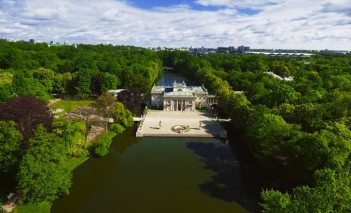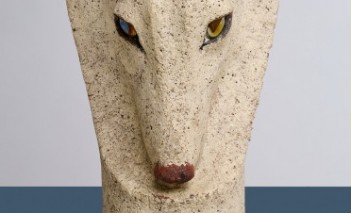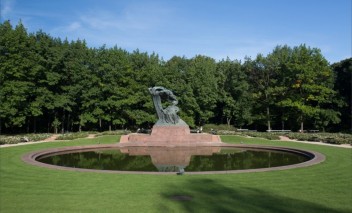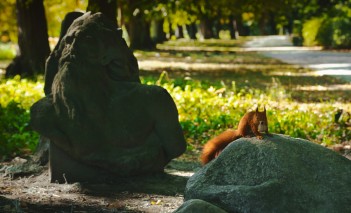Exhibition of the painting "Vytautas's Oath" by Jan Styka
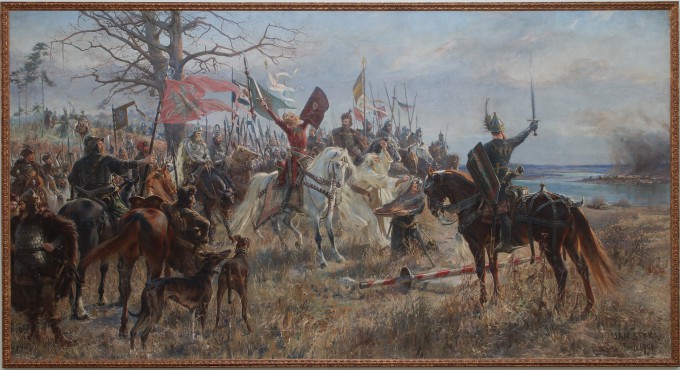
The monumental work "Vytautas vows revenge against the Teutonic Knights against the backdrop of a burning Kaunas" by Jan Styka, one of the most famous Polish battle painters, will be on display from 9 September to 14 November 2021 at the Royal Łazienki Museum. The exhibition was organised to mark the 30th anniversary of resumption of diplomatic relations between Poland and Lithuania.
Jan Styka’s painting will be presented in the recently renovated Kubicki Stables. The exhibition will be accessible from Tuesday to Thursday from 10.00 to 16.00 and from Friday to Sunday from 10.00 to 18.00. Admission in November is free as part of the "Free November" campaign.
The exhibition is organised by the Royal Łazienki Museum. Partners: Embassy of the Republic of Lithuania in the Republic of Poland and Vytauto Didžiojo Karo Muziejaus. Patron of the Museum: PZU. The exhibition was co-financed by the Ministry of Culture, National Heritage and Sport.
"Vytautas's Oath" – what does the painting of Jan Styka depict?
The work by Jan Styka (1858–1925), one of the leading painters of the turn of the 19th and 20th centuries, author of historical and battle scenes, creator of allegorical and religious paintings, portraitist and co-author of "Panorama of the Battle of Racławice", dates from 1901. It was created in Paris, where the artist lived with his family at the time. Styka devoted over a year of work to this monumental painting.
The painting glorifies Duke Vytautas (1354 [?]–1430; Grand Duke of Lithuania from 1398), an outstanding leader and politician who at the turn of the fifteenth century left a strong mark on the history of Lithuania and that of the entire region. The painting depicts the duke surrounded by several leading representatives of the Gediminid dynasty which had ruled Lithuania since the end of the thirteenth century and from which the Jagiellonians were descended.
WHO IS WHO IN THE PAINTING BY JAN STYKA?
In the background, you can see the burning Kaunas Castle, considered the gateway to central Lithuania and the arena of numerous struggles against the Teutonic Order. Its capture by the Teutonic Knights in 1362 is the first event to have been recorded in the city’s history.
Duke Vytautas holds a special place in Lithuanian history. The Polish chronicler Jan Długosz (known as Johannes Longinus) described him as follows: 'In our age people are of the opinion that no contemporary duke could match Vytautas in his magnificence of mind and diligence in matters (...) and it is certain that Lithuania’s greatness rose with him and ended with his death'.
He was an advocate of the independence of the state and continued the power politics of his ancestors (expansion into Ruthenia). He is usually pitted against his cousin Jogaila, crowned king of Poland (as Jagiełło) in 1386, who pursued a broad concept of a Polish-Lithuanian union, which – according to Vytautas – was contrary to the interests of Lithuania. Despite this, the relations between the relatives, grandsons of Gediminas, the founder of the dynasty’s power, were marked both by periods of hostility and cooperation. The latter culminated in the Polish-Lithuanian victory at Grunwald (Lith.: Žalgiris; Ger.: Tannenberg).
"Vytautas's Oath" and "The Battle of Grunwald"
For Poland and Lithuania, the conflicts with the Order are an important part of the national tradition and their significance for the establishment of both state organisms cannot be overestimated. The "Vow" is as much a symbol for the Lithuanians as Jan Matejko’s "The Battle of Grunwald" is for the Poles. In fact, these monumental works have much in common. Not only because of the historical inaccuracies and the glorification of Vytautas, who is shown in an almost identical way in both instances (the inspiration from the "Grunwald" painting – and not the only one – is obvious). What is most striking is the totally ahistorical presentation of the clothing and military equipment (with exceptions), as well as the portrayal of a number of iconic figures in one place and at the same time. In Styka’s painting, apart from Vytautas (Pol.: Witold), these are mainly the old dukes Algirdas and Kęstutis (Vytautas’s father), clad in steel armour and symbolising unwavering fraternal unity in the face of the Teutonic threat. The younger generation is represented by their sons, Jogaila (our attention is drawn to the two swords, one at his belt, the other raised, which is probably a reference to the 'naked' swords at Grunwald/Tannenberg), his brothers Skirgalia and Švitrigaila, and Vytautas’s brother Sigismund Kęstutaitis, i.e. persons who exerted a significant influence on the history of late mediaeval Lithuania. The pagan character of the then Lithuanian state is emphasized by the fortune-teller priest (Lith.: krivis), and the connection with Samogitia, a historical land (Lower Lithuania) plagued by incessant Teutonic 'raids', by a warrior in scale armour and an ancient helmet with a nose piece.
From a historical perspective, the scene painted by Styka is highly questionable, if only due to the age of some of the personages. Vytautas was probably only a few years old, and Jogaila may not have yet been born when the Teutonic Knights conquered Kaunas in 1362. The painting, however, was not meant to be a history lesson; this was not the artist’s goal. Styka symbolically referred to the heroic history of Lithuania, a country with a centuries-old tradition, an important part of which were the achievements of Grand Duke Vytautas.
The work of Jan Styka in the Lithuanian museum
Before the painting came to Kaunas, where it still holds a place of honour at the permanent exhibition of the Vytautas the Great War Museum, it was exhibited in many museums in Poland. For a long time it was also in the possession of the Tyszkiewicz family and adorned their estate in Raudondvaris (Pol. Czerwony Dwór) near Kaunas. In 1937 it was bought by the Museum directly from the widow of its author.
